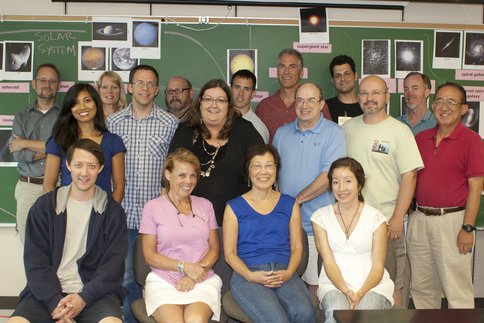2011 Annual Science Report
 University of Hawaii, Manoa
Reporting | SEP 2010 – AUG 2011
University of Hawaii, Manoa
Reporting | SEP 2010 – AUG 2011
EPO Activity: 2011 ALI'I
Project Progress
Ongoing since 2004 summer, ALI’I has been increasing in depth of content to accommodate returning teachers, some for the third summer, and involving our UH NAI scientists in the integration of astrobiology concepts. As such, the complexity challenged those participating for the first time in 2011. Our focus for 2011 was the development of a cadre of ALI’I master teachers. (Figure 1) The ALI’I topics of geochemistry, cosmochemistry, evolutionary biology, and astronomy integrated together were intended to solidify the astrobiology knowledge base of our potential master teachers. Our scientists wanted to work with ALI’I teachers to develop curriculum activities suitable for the astrobiology concepts being promoted but the teachers need time to digest this. Therefore, we will have master teachers develop activities advised by our NAI scientists before 2012 ALI’I so they can be used with new participants next summer.
Several master teachers will be sharing astrobiology lessons and posters at the following 2012 national teacher conferences. 1. American Association of Physics Teachers, Feb, and July, 2012. 2. AbSciCon, April, 2012. 3. National Association of Teachers of Biology (NABT), Oct, 2012. We are seeking external funding to support them and assisting them with grant writing to expand and promote astrobiology education in the middle and high school classroom. We are collaborating with RPI, Penn State and JPL Icy Worlds NAI teams to have ALI’I master teachers living in their areas help with workshops and will expand this effort to other teams.
A formal evaluation was conducted by Aaron Price, who has PhD in science education from Tufts University, and by Sheri Fitzgerald, who will be completing her PhD in science education from University of Hawaii in 2012. Dr. Price conducted a survey of past participants and presented the quantitative results of this ALI’I evaluation at our NAI Central EPO monthly telecom in November. Ms. Fitzgerald did the qualitative analysis by interviewing the 2011 ALI’I returning and new teachers. Overall, the results were positive. Daniella Scalice, our NAI Central EPO manager, has the completed report.
Teachers from New Hampshire and Hawaii are studying mineral samples of chondrules seen through a polarizing microscope as part of an activity developed by UHNAI Co-I Gary Huss, director of the W. M. Keck Cosmochemistry Laboratory.
A colorful zoomed image of Julesburg meteorite sample seen through the polarizing microscope which all ALI’I teachers have never seen before at any workshop. Thus, this popular activity brings smiles to the participants’ faces.
2011 ALI’I group photo with 6 returning teachers and first timers who teach special needs students, as well as biology, physics, earth and space science environmental science and astrobiology courses in middle and high schools in eight different states.


